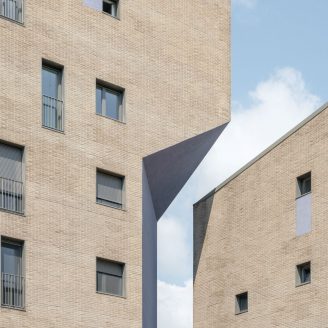Recently completed, the new residential complex in Via Valtorta in Milan has been designed by Cino Zucchi Architetti to consolidate and enrich the existing urban fabric.
The new residential volumes play a key role in this project to create a sense of unity and cohesion between the existing and new buildings. This integration is made possible by adjusting the heights of the residential complex, with the lowest block placed near the historic buildings along Via Valtorta. These height variations also consider different perspectives and panoramic views, while simultaneously responding to the constraints of the terrain and solar orientation in different seasons.
A distinctive project element is the new urban front that forms along Via Valtorta and Via Rovetta. The variation in heights is connected by a continuous and uniform base that defines the residential entrances. This base accommodates a series of commercial activities on the north side and creates small private spaces for public use, serving both the lot entrances and the city itself.
The project focuses on permeability on the ground floor between the buildings and the large inner courtyard. Here, there are commercial spaces along Via Valtorta, accessible through two passageways that provide access to the yard, stairwells, and technical and service rooms. The northeast corner is reserved for a bar or a small neighbourhood shop, completing the vitality of the ground floors along Via Valtorta and Via Rovetta.
The arrangement of the driveway ramp to the east provides access to the private parking at the basement level of the residence, ensuring an efficient flow of vehicles and compliance with traffic regulations.
The apartments, evenly distributed and well connected through a central staircase, feature spacious and bright spaces in various sizes, with the larger ones on the tower’s upper floors featuring duplex flats. The main living areas on the south side always have significant loggia-balconies with large windows, while the rest of the façade is characterized by a relatively compact and regular masonry curtain, with the bedrooms and bathrooms’ windows integrated.
The choice of materials reflects a meticulous consideration for the Milanese architecture of the twentieth century and the desire to create a distinctive visual identity. The plaster for the main facades facing the streets is applied on an external insulation system, while the base and minor fronts feature brick cladding. As regards the parapets of the south-facing views, which are mainly glazed, they are completed with inclined portions made of metal sticks which articulate the façades overlooking the green garden.
This diversification of materials expresses the desire to continue the search for a relationship between the project and the adjacent lots without reproducing their forms and materials.

TERRACOAT BY TERREAL ITALIA PLAYS A KEY ROLE
TERRACOAT®, Terreal Italia‘s terracotta-finished thermal insulation system, was used to clad the Via Valtorta residential complex in Milan.
TERRACOAT® is an efficient construction solution consisting of a thermal insulation coat specifically designed for energy qualification and living comfort interventions.
The panels have already applied the finish in exposed face laths and thus facilitate the prefabrication of the exposed face finishes, which were previously always done by manual laying of one brick/lath at a time.
The panels are prefabricated by assembling slabs of EPS with graffite added and 2-cm-thick “soft-paste” facing terracotta laths. The special assembly system ensures that the two elements are firmly glued together to create a single, indivisible body with very high resistance to weathering.
The small size, equivalent to 0.54 sq m per panel, and the limited weight (about 17.4 kg) make the panel very versatile in the logistics stages and allow for speed and ease of installation. The panels are mechanically fastened to any support structure.
Finally, the TERRACOAT® system ensures a high thermal performance of the building as well as improving the aesthetic appearance thanks to the soft-paste facing terracotta laths in the varieties of finishes and colors of the SanMarco and Pica range.














